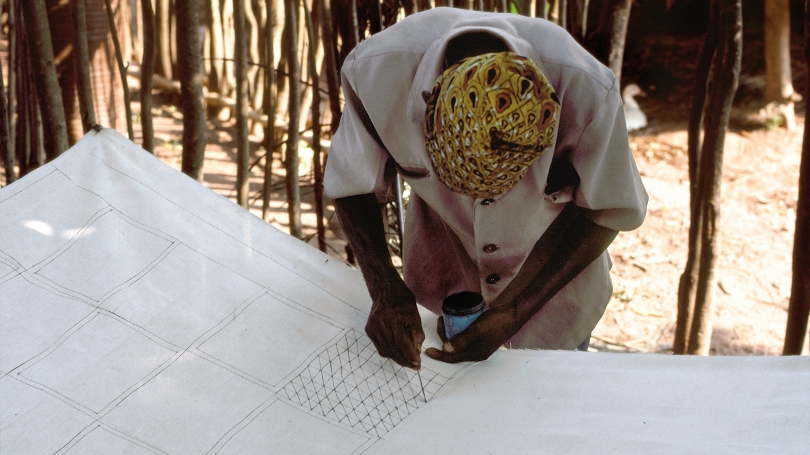This exhibition examines the ukara cloth of the Ekpe secret society, a multi-ethnic all-male association in southeastern Nigeria and western Cameroon, exploring both the longstanding cultural practice the cloth represents and the artistic process involved in its creation. The cloth is made of plain cotton but transformed into a ritual object when nsibidi symbols are inscribed onto it through indigo dyeing. Nsibidi is a body of ideographic, abstract, and gestural signs deployed by the Ekpe society as a form of coded communication. In part because of their appropriation, exclusive use, and understanding of nsibidi, Ekpe members in the pre-colonial past were thought to have access to the spiritual realm and were, therefore, empowered to make and enforce societal rules and norms. While their political authority is largely diminished today, Ekpe membership is still prestigious and the society continues to be a unifying force among the Ejagham, Igbo, Efik, Ibibio, and other cultural groups in the Cross River region.
Worn as personal wrappers during initiations and at social events, ukara cloth distinguishes Ekpe members. Covering, concealing, and protecting their bodies, it functions as a physical metaphor for the ideological secrecy that the Ekpe society carefully constructs and guards. Ukara cloth also consecrates the interior of Ekpe lodges, where larger versions of the cloth hang as backdrops. Imbued with transcendental aura, ukara conveys the sacrality and prestige of the Ekpe secret society.
The process of creating this richly symbolic cloth is laborious. Although used exclusively by members of Ekpe, ukara is produced by a sub-group in a village of the Ezillo community in present-day Ebonyi State in the Igbo area in southeastern Nigeria. Each ukara is highly individualized and clearly produced to be worn by a specific Ekpe member or to mark a specific Ekpe lodge. Ekpe members request nsibidi designs of personal or communal significance. The design is left to the discretion of the Ezillo creators, who are not Ekpe members and do not know the meanings of nsibidi. These artists sew the white cloths with raffia thread so that parts of the ukara (in a pattern of nsibidi symbols) will not be exposed during the dyeing process. The cloth is then dipped in indigo dye and hung to dry. When the threads are cut, the nsibidi designs stand out, white against a deep blue background. The symbols are arranged in a grid, giving the cloths an orderly, symmetrical quality that is often reinforced by repeated patterns. The nsibidi may convey meaning either singularly or in groups, and each sign may be figurative, geometric, or abstract, or may represent a physical object, concept, or narrative. Individual symbols may also have multiple meanings, rendering context important and interpretation inevitable in the "reading" of the body of represented signs.
This exhibition, on view from April 18 to August 2, was organized by the Hood Museum of Art, Dartmouth College, and generously supported by the William B. Jaffe and Evelyn A. Hall Fund. Objects and images in the exhibition courtesy of Dr. Eli Bentor.




